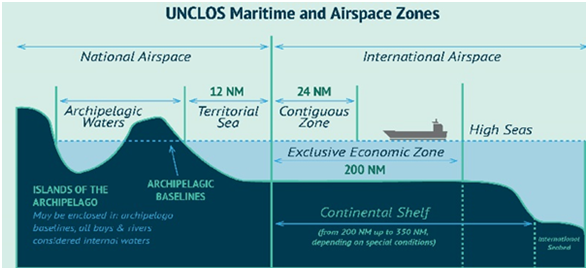

22th February 2023 (9 Topics)
Context
The UN wants to protect the high seas as they make up more than 60% of the world’s oceans and draw less attention than coastal waters.
Background
- Around 51 countries want to join the treaty as asked by United Nations at New York.
|
Fishing, shipping, tourism and ocean protection are currently controlled by around 20 organizations. However, their regulations only apply to a distance of 200 nautical miles (370 kilometres) from the coast. |
- Although the high seas make up more than half of the surface of the Earth and 61% of all oceans, only 1% of international waters are under protection.
- Need for conservation:
- Illegal fishing, overfishing and other forms of damage to the ecosystem, such as deep-sea mining, oil and gas drilling, can hardly be monitored, tracked or prosecuted in a consistent way.
About
About New Treaty:
- The UN general assembly decided to convene an Intergovernmental Conference (IGC) in December 2017 to elaborate on the text of the legal instrument for protecting biodiversity in areas beyond national jurisdiction (BBNJ) under UNCLOS.
- The IGC held four formal sessions in September 2018, March 2019, August 2019 and March 2022.
- The ambition of the treaty is to reverse the current downward trend in biodiversity and protect marine life, while also guaranteeing safe access to international waters.
- The treaty will help conserve biodiversity in areas beyond national jurisdiction (BBNJ) that lie outside countries’ 322-kilometre exclusive economic zones.

What would a High Seas Treaty do?
- The "high seas" refers to international waters — sea space that doesn't fall within any nation's sovereign or extended maritime zone.
- About two-thirds of the world's water is considered high seas and, as of today, only about 1% of that area is covered by international agreements on fishing and other resource extraction.
- The high seas treaty, if agreed upon, would create a new global body to enforce rules laid out to protect about 30% of the world's oceans by 2030.
- It would extend international law beyond countries' territorial waters and exclusive economic zones (EEZs), which extend 200 miles from any nation's coastline, to cover a major portion of the currently unprotected waters from threats such as overfishing and unchecked seafloor mining.
- This treaty will provide a first-ever legal framework for the protection of biodiversity in international waters, including the creation of ocean sanctuaries, environmental rules, and the application of Environmental Impact Assessments preceding any human activities on the waters that make up nearly half of the planet.
|
UN Convention on the Law of the Sea (UNCLOS):
|
More Articles


